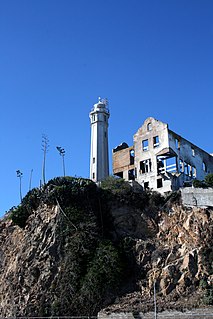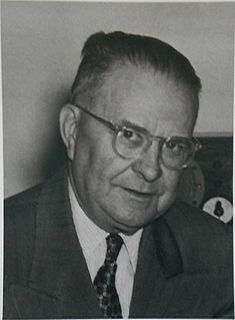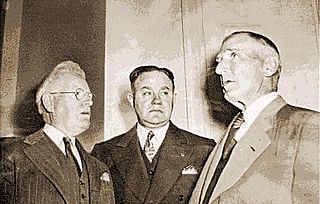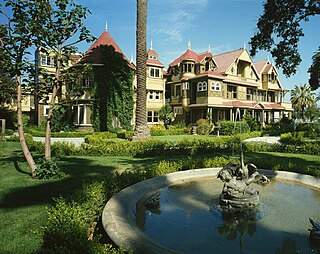
Alcatraz Island is located in San Francisco Bay, 1.25 miles (2.01 km) offshore from San Francisco, California, United States. The small island was developed with facilities for a lighthouse, a military fortification, a military prison, and a federal prison from 1934 until 21 March 1963. The water currents around the island were high at all times, which presumably decreased the chance of an inmate escaping.

Robert Franklin Stroud, known as the "Birdman of Alcatraz", was a convicted murderer, American federal prisoner and author who has been cited as one of the most notorious criminals in the United States. During his time at Leavenworth Penitentiary, he reared and sold birds and became a respected ornithologist, although regulations did not allow him to keep birds at Alcatraz, where he was incarcerated from 1942 to 1959. Stroud was never released from the federal prison system; he was imprisoned from 1909 to his death in 1963.

McNeil Island is an island in the northwest United States in south Puget Sound, located southwest of Tacoma, Washington. With a land area of 6.63 square miles (17.2 km2), it lies just north of Anderson Island; Fox Island is to the north, across Carr Inlet, and to the west, separated from Key Peninsula by Pitt Passage. The Washington mainland lies to the east, across the south basin of Puget Sound.

Alcatraz Island Lighthouse is a lighthouse – the first one built on the U.S. West Coast – located on Alcatraz Island in California's San Francisco Bay. It is located at the southern end of the island near the entrance to the prison. The first light house on the island was completed in 1854, and served the bay during its time as a Citadel and military prison. It was replaced by a taller concrete tower built in 1909 to the south of the original one which was demolished after it was damaged due to earthquake in 1906. The automation of the lighthouse with a modern beacon took place in 1963, the year Alcatraz closed as the Alcatraz Federal Penitentiary. It is the oldest light station on the island with a modern beacon and is part of the museum on the island. Although when viewed from afar it easily looks the tallest structure on Alcatraz, it is actually shorter than the Alcatraz Water Tower, but as it lies on higher ground it looks much taller.
The General Frank M. Coxe is a steam ferry which was built for the United States Army to provide transportation services among several military facilities that ring California's San Francisco Bay.

The June 1962 Alcatraz escape was a prison break from Alcatraz Federal Penitentiary, a maximum-security facility located on an island in San Francisco Bay, undertaken by inmates Frank Morris and brothers John and Clarence Anglin. The three men were able to escape from their cells and leave the island in a raft.

Alcatraz water tower is on Alcatraz Island in the San Francisco Bay, off the coast of San Francisco, California. It is located on the northwestern side of the island, near Tower No. 3, beyond the Morgue and Recreation Yard. The water tank is situated on six cross-braced steel legs submerged in concrete foundations.

Alcatraz Dining Hall, often referred to as the Mess Hall, is the dining hall of Alcatraz Federal Penitentiary where the prisoners and staff ate their meals. It is a long wing on the west end of the Main Cellhouse of Alcatraz, situated in the center of the island. It is connected to the block by a corridor known as “Times Square”, as it passes beneath a large clock approaching the entrance way to the dining hall. This wing includes the dining hall and the kitchen beyond it.

The Warden’s House was the home of the wardens of the federal penitentiary on Alcatraz Island, off San Francisco. It is located at the northeastern end of the Main Cellblock, next to Alcatraz Lighthouse. The 3-floor 15-room mansion was built in 1921 according to the Golden Gate National Recreational Area signpost, although some sources say it was built in 1926 or 1929 and had 17 or 18 rooms.

Building 64, also known as the Building #64 or the Building 64 Residential Apartments, was the first building constructed on the island of Alcatraz off the coast of San Francisco, USA, entirely for the purpose of accommodating the military officers and their families living on the island. Located next to the dock on the southeastern side of the island below the Warden's House, the three-story apartment block was built in 1905 on the site of a U.S. Army barracks which had been there from the 1860s. It functioned as the Military Guard Barracks from 1906 until 1933. One of its largest apartments in the southwest corner was known as the "Cow Palace" and a nearby alleyway was known as "Chinatown".

The Recreation Yard was the yard used by inmates of Alcatraz Federal Penitentiary between 1934 and 1963. It is located adjacent to the Dining Hall northwest of the end of D-Block on a raised level surrounded by a high wall and fence above it. Guard Tower #3 lay just to the west of the yard. The gun gallery was situated in the yard, mounted on one of the dining hall's exterior walls. The recreation yard faced the mainland.

The Social Hall, also known as the Officers' Club, was a social club located on the northwestern side of the island of Alcatraz, off the coast of San Francisco, USA. Located in close proximity to the Power House, water tower and Former Military Chapel, it formerly housed the post exchange. The club was a social venue for the Federal Penitentiary workers and their families on the island to unwind after a hard week's work dealing with America's most hardened criminals after they'd been locked up at 17:30. It was burned down by a fire of disputed origins during the Occupation of Alcatraz in 1970; leaving a shell which still remains.

Fort Alcatraz was a United States Army coastal fortification on Alcatraz Island near the mouth of San Francisco Bay in California, part of the Third System of fixed fortifications, although very different from most other Third System works. Initially completed in 1859, it was also used for mustering and training recruits and new units for the Civil War from 1861 and began secondary use as a long-term military prison in 1868.

The Alcatraz Federal Penitentiary or United States Penitentiary, Alcatraz Island was a maximum security federal prison on Alcatraz Island, 1.25 miles (2.01 km) off the coast of San Francisco, California, United States, the site of a fort since the 1850s; the main prison building was built in 1910–1912 as a United States Army military prison. The United States Department of Justice acquired the United States Disciplinary Barracks, Pacific Branch, on Alcatraz on 12 October 1933, and the island became a prison of the Federal Bureau of Prisons in August 1934 after the buildings were modernized and security increased. Given this high security and the island's location in the cold waters and strong currents of San Francisco Bay, prison operators believed Alcatraz to be escape-proof and America's strongest prison.

Edwin Burnham Swope, nicknamed "Cowboy", was the second warden of Alcatraz Federal Penitentiary, which was situated on Alcatraz Island, California, US. He was a native of New Mexico, having been born at Santa Fe in 1888. His earlier posts as warden included New Mexico State Prison, Washington State's McNeil Island Federal Penitentiary, and the Federal Penitentiary at Terre Haute, Indiana.

Rufe Persful was an American criminal, convicted for murder, kidnapping and robbery. He was considered one of the most dangerous criminals of his era by the authorities. Convicted with the murder and robbery of an elderly man at the age of 18, he was sentenced to 15 years in Arkansas State Penitentiary, but unlike a standard prison, it involved farm labour. He was given the task of shooting fellow inmates with a shotgun if they attempted to escape. He killed and disabled many prisoners during his time at the Arkansas Penitentiary, punctuated by periods of parole as a reward for his prison protection, and then re-offending and being sent back to resume his role. In December 1934, Persful was convicted for kidnapping and robbery in Paragould, Arkansas and sentenced to 20 years, after which he was transferred to United States Penitentiary, Atlanta. Two inmates recognized him from Arkansas and word spread of his killing of fellow inmates and he began being severely abused. He was transferred to Alcatraz Federal Penitentiary a year later but was recognized and continued to be tortured by his fellow inmates because of his past offenses. In 1937, it was Persful who attempted to cut off his hands in sheer desperation of his experiences at Alcatraz and was diagnosed with schizophrenia. He was eventually sent to McNeil Island Penitentiary where he was again recognized and suffered much abuse from his fellow inmates, despite being heavily watched over by the prison staff. He was released in April 1948 and moved in with a relative in Gary, Indiana, never to be convicted of a crime again.

Edward Joe Miller,, also known as E. J. Miller, was an American prison administrator. A native of Kansas, he was the second Associate Warden of Alcatraz Federal Penitentiary under James A. Johnston in the late 1930s and 1940s. Both men were known for their strict discipline.
Cecil John Shuttleworth was an American prison administrator. He was the first Associate Warden of Alcatraz Federal Penitentiary under James A. Johnston from 1934. Both men were known for their strict discipline and known as "iron men". A few years later he became associate warden of Leavenworth in Kansas. On January 1, 1942 became warden of the Prison Camps/Federal Correctional Institution, Milan in Michigan.

Alcatraz Wharf is located on the southeast side of Alcatraz Island, in San Francisco Bay, California, US. Classified as building number 33 of the Alcatraz Island National Historic Landmark, its historic name variants were "Alcatraz Dock" and "Alcatraz Pier". It is the main access point to Alcatraz. Another dock on the island's northwest side was only used for rock loading. The wharf contained many of the islands historic buildings, including Building 64, the Bombproof Barracks, Chinatown, Ranger Office, Garage, Dock Tower, Storage Vault, and Firebox #3.

There are many reportedly haunted locations in San Francisco, California. According to ghost hunters, over 100 sites in the San Francisco Bay Area are reported to be haunted.





















